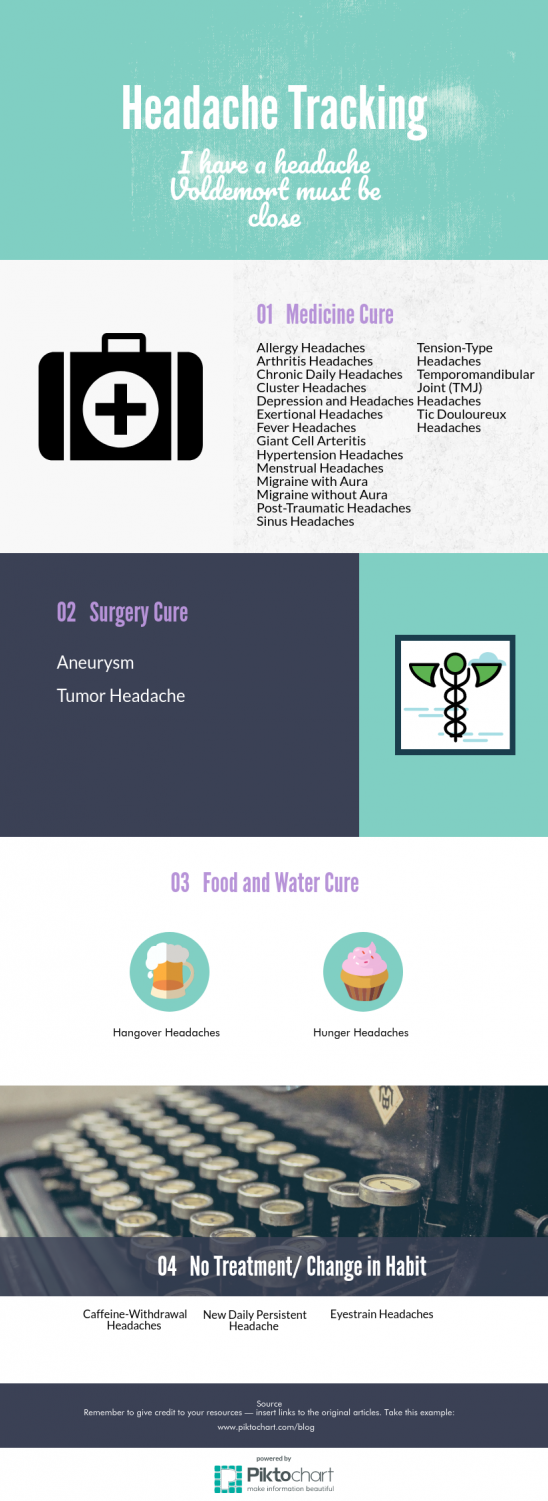Headaches and migraines decoded
Millions of people suffer from the pain related to headaches and migraines everyday. “It [my headaches] feels very tight all around my skull, like someone is just grabbing my head and squeezing it. Sometimes my head feels really hot around my temples and the back of my neck where the spine and head connect. At its worst, my temples have a really sharp pain, like someone is poking them with hot knives,” sophomore Tali Porter said.
October 23, 2017
To me, a migraine feels like a baseball traveling 80mph hitting my head repeatedly. A headache pain level would equal about an eighth of this. People diagnosed with migraines do not react very well when someone calls their migraine a headache because it does not justify the pain level they feel. In fact, 24 different types of headaches and migraines exist today. Knowing the difference between headaches and migraines and how to help yourself and others in the event of a migraine or headache can prevent future or current pain from occurring.
“The medical term [for a headache] is cephalalgia. It is a feeling of pain that can occur on either both sides or just one side of the head or neck. Headaches can be sharp, dull, or throbbing, and can radiate to different areas of the head. They typically last less than an hour but can last for several days,” Dr. Bennett Machanic describes.
Migraines start as a dull ache and then gradually develop into a pulsing pain that usually takes place in the temples, and the front and back of one, or both sides of the head.
“About 15-20% of people with migraines get an “aura,” which is a manifestation of neurological symptoms that occur before a migraine headache,” the National Headache Foundation said.
An aura affects all of the senses. Some may see lines or dots in their vision, experience tunnel vision, or any other type of hallucination.
“Other symptoms include numbness, a “pins and needles” sensation, or difficulty in recalling or speaking words properly,” National Headache Foundation said.
Neurological events may last as long as sixty minutes and will fade as the headache begins. Migraines usually occur regularly, which means people that suffer from the extreme headache often take some form of medication. Doctors commonly prescribe anti-depressants or use a treatment plan, such as herbal remedies, to stop, prevent, or diminish the aching pain.
A headache feels less painful in comparison to a migraine, although the pain may focus on certain areas more, depending on the functioning headache. A headache can begin from chemicals in the air, lack of sleep, and different foods. Four different types of headache treatments exist: food and water, change in habit, medicine, and in extreme circumstances, surgery.
The most common types of headaches include tension, sinus, and cluster headaches. Tension headaches occur randomly and usually start because of temporary stress, anxiety, fatigue, or anger.
Symptoms of a tension headache entail a band-like sensation around the head, contract the head and neck muscles, and a feeling of pressure builds up in the head.
Sinus or allergy type headaches arise with seasonal allergies and coincide with nasal congestion and watery eyes.
Cluster headaches result from a chemical reaction in the brain and their pain comes in 5-10 minute waves. A bloodshot eye and infuriating pain occurs on one side of the head, and doctors prescribe medication or increased oxygen to treat the cluster, but this only helps to some extent.
Overall, headaches, as painful as they persist, remain treatable in most cases and seem or feel more frightening than they prevail. Migraines and headaches continue to bring pain to anyone experiencing them, and most people cannot tell the difference between them. Migraines require a diagnosis and prescription from a doctor, while people bring on their own self-induced and self-diagnosed headaches. Other differences include different locations, different feelings, and an increasing or decreasing level of pain and tolerance.
“[When I get a migraine there is] pain behind my eyes and I can’t see well and my eyes water. Everytime light shines into my eyes I get a stabbing pain [in my head],” sophomore Cassidy Mason said.
A disadvantage and a debilitating feeling that makes one feel weak and lazy, explains why people need to know the difference, especially when a friend or loved one experiences migraines. It shows that one knows the pain level. It shows that they care.



![Millions of people suffer from the pain related to headaches and migraines everyday. “It [my headaches] feels very tight all around my skull, like someone is just grabbing my head and squeezing it. Sometimes my head feels really hot around my temples and the back of my neck where the spine and head connect. At its worst, my temples have a really sharp pain, like someone is poking them with hot knives,” sophomore Tali Porter said.](https://nchschant.com/wp-content/uploads/2017/10/cover-2-900x600.jpg)

